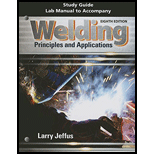
Study Guide with Lab Manual for Jeffus' Welding: Principles and Applications, 8th
8th Edition
ISBN: 9781305494701
Author: Larry Jeffus
Publisher: Cengage Learning
expand_more
expand_more
format_list_bulleted
Textbook Question
Chapter 26, Problem 12R
What is a eutectic composition?
Expert Solution & Answer
Trending nowThis is a popular solution!

Students have asked these similar questions
4. Solve for the support reactions at A and B.
W1 600 lb/ft
W2 150 lb/ft
A
B
In cold isostatic pressing, the mold is most typically made of which one of the following:
thermosetting polymer
tool steel
sheet metal
textile
rubber
The coefficient of friction between the part and the tool in cold working tends to be:
lower
higher
no different relative to its value in hot working
Chapter 26 Solutions
Study Guide with Lab Manual for Jeffus' Welding: Principles and Applications, 8th
Ch. 26 - What gives metals their desirable properties?Ch. 26 - What is heat?Ch. 26 - What are the basic units of measure for heat?Ch. 26 - What is sensible heat?Ch. 26 - Prob. 5RCh. 26 - What does the color of light given off from a hot...Ch. 26 - Prob. 7RCh. 26 - In steel-making, what is ore combined with in the...Ch. 26 - Prob. 9RCh. 26 - What is an alloy?
Ch. 26 - Using Figure 26-18, answer the following...Ch. 26 - What is a eutectic composition?Ch. 26 - Using Table 26-3, what are the lowest and highest...Ch. 26 - Approximately how many degrees wide is the...Ch. 26 - Referring to Figure 26-20, what color would...Ch. 26 - Referring to Figure 26-20, what is the approximate...Ch. 26 - Prob. 17RCh. 26 - Referring to Figure 26-20, above what temperature...Ch. 26 - Prob. 19RCh. 26 - What is known as the critical temperature of...Ch. 26 - Can a metal have all the mechanical properties at...Ch. 26 - What other properties can a metal's hardness...Ch. 26 - Which property, brittleness or ductility, will let...Ch. 26 - What is toughness?Ch. 26 - What are the common types of strength...Ch. 26 - Prob. 26RCh. 26 - What are the three steps in precipitation...Ch. 26 - How do ferrite and cementite work together to form...Ch. 26 - Why is brine quenching faster than water...Ch. 26 - What can be done to speed up the quenching rate in...Ch. 26 - Why is the formation of martensite a problem when...Ch. 26 - How can the effects of cold working be removed?Ch. 26 - Prob. 33RCh. 26 - Referring to Figure 26-20, what would the preheat...Ch. 26 - Why must the stress-relieving temperature be kept...Ch. 26 - What properties can annealing produce in metals?Ch. 26 - How long does it take the weld metal to go through...Ch. 26 - What are some sources of hydrogen that can...Ch. 26 - How can nitrogen get into an SMA weld?Ch. 26 - What are some of the problems that oxygen can...Ch. 26 - When do cold cracks develop?Ch. 26 - What is carbide precipitation?
Knowledge Booster
Learn more about
Need a deep-dive on the concept behind this application? Look no further. Learn more about this topic, mechanical-engineering and related others by exploring similar questions and additional content below.Similar questions
- The force F={25i−45j+15k}F={25i−45j+15k} lblb acts at the end A of the pipe assembly shown in (Figure 1). Determine the magnitude of the component F1 which acts along the member AB. Determine the magnitude of the component F2 which acts perpendicular to the AB.arrow_forwardHi can you please help me with the attached question?arrow_forwardHi can you please help me with the attached question?arrow_forward
- Please can you help me with the attached question?arrow_forward4. The rod ABCD is made of an aluminum for which E = 70 GPa. For the loading shown, determine the deflection of (a) point B, (b) point D. 1.75 m Area = 800 mm² 100 kN B 1.25 m с Area = 500 mm² 75 kN 1.5 m D 50 kNarrow_forwardResearch and select different values for the R ratio from various engine models, then analyze how these changes affect instantaneous velocity and acceleration, presenting your findings visually using graphs.arrow_forward
arrow_back_ios
SEE MORE QUESTIONS
arrow_forward_ios
Recommended textbooks for you
 Welding: Principles and Applications (MindTap Cou...Mechanical EngineeringISBN:9781305494695Author:Larry JeffusPublisher:Cengage Learning
Welding: Principles and Applications (MindTap Cou...Mechanical EngineeringISBN:9781305494695Author:Larry JeffusPublisher:Cengage Learning

Welding: Principles and Applications (MindTap Cou...
Mechanical Engineering
ISBN:9781305494695
Author:Larry Jeffus
Publisher:Cengage Learning
Intro to Ceramics and Glasses — Lesson 2, Part 1; Author: Ansys Learning;https://www.youtube.com/watch?v=ArDFnBWH-8w;License: Standard Youtube License